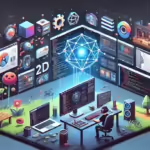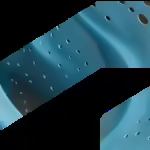PTC’s LiveWorx user conference showcases tools for creating smart connected everything.
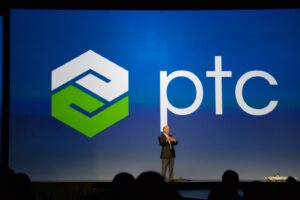
“We are citizens of the new world,” declared Jim Heppelmann as he opened PTC’s second annual LifeWorx user conference. LiveWorx is PTC’s user conference for all its users and all its products, but the message coming from the keynote stage was primarily about the company’s new direction into IoT and even the name LiveWorx is taken from its ThingWorx division, which seems to be getting most of the attention from PTC executives. Perhaps some long-term PTC users were feeling a little left out. They should not have, because to PTC CEO Jim Heppelmann’s – everything is thing.
Certainly, plenty of users wanted to hear about PTC’s plans. LiveWorx attracted over 4,500 attendees and 4,100 more who attended via livestream from over 40 countries.
Along with the rest of the CAD industry, PTC is on the long march to Industry 4.0. The vision first expressed in Germany as the next step forward for manufacture and design and the digital world and real world become interrelated and mutually dependent.
With the acquisition of ThingWorx in 2013, PTC began building out the left side of the real world with tools to connect and communicate with devices, machines, and sensors. On the right side, the digital world, PTC has, quite a bit of breadth including design, data management, documentation, and service. Most recently it’s been knitting up the middle with new digital services tools, analytics, and VR and AR.
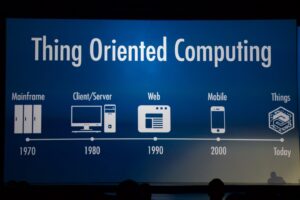
Connected Services
At Liveworx, PTC announced its Remote Service and Connected Services Parts Management tools, which says the company will enable customers to do three things: Understand, Advance, and Outperform in their markets. PTC says they’re giving their customers a roadmap for smart, connected service. The connected services products are part of the ThingWorx portfolio and will enable customers to analyze service and product data in real time, devise a plan of action, and create better service options as a means of differentiation.
PTC Remote Service gives service and support technicians the ability to remotely identify and resolve problems. Real-time monitoring helps companies anticipate problems and reduce service costs and improve customer services.
PTC Connected Service Parts Management lets companies manage service and equipment availability. Customers can use the information coming from connected assets to forecast and plan service and parts demand with information on asset location and performance.
Listening to the things
Heppelmann told the audience that impact of Industry 4.0 “changes everything.” We’re seeing the start of a huge revolution as objects become smarter and need less input from humans. For instance, mass connectivity has enabled ride-sharing services like Uber; the next step is autonomous cars that services can send to us when needed. In the future companies might not be in the car business, they’ll be in the transportation business.
When it comes to industrial vehicles, the future is happening more rapidly. Machines used for mining, construction, agriculture, are already tracked and automated. Caterpillar is working closely with PTC’s ThingWorx group to add monitoring and communications to machines in the field. Terry Lewis, the digital and technology director at Caterpillar said modern machines are becoming more efficient and more dependable, and they are needing less service. “If we do a real good job,” says Lewis, we sell less parts; we sell less equipment.” She jokes that as this dynamic progresses, it would be terrible to have 100 percent market share. Yet, as companies transition to leasing heavy machinery rather than selling it, the ability to ensure their continuous uptime and good repair becomes a much better value proposition.
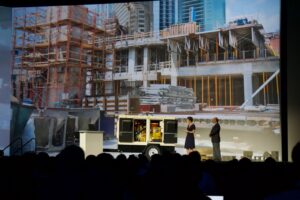
The digital meets the real: Terry Lewis, digital and technology director at Caterpillar, and PTC CEO Jim Heppelmann demonstrate the IoT at work on industrial machines. (Source: JPR)
Taking it to the edge
Over the past few years, there has been a huge focus on big data; systems have been built to gather the information coming from machines, builds, and devices. As it turns out, there’s such a thing as too-big data. Much of the information coming from things doesn’t call for immediate action. It might never be useful, or it might help to develop trends, but there is a need to sort out critical data that demands some sort of response.
PTC is building their end of the system using their new Kepware technology acquired in December, 2015 and Coldlight also acquired in 2015. The company says the integration of Kepware with its ThingWorx technology enables sensor data to be ingested and processed to enable real-time anomaly detection and failure prediction. The technology from Coldlight provides analysis. The company showed an example from FlowServe, manufacturer and aftermarket service provider of flow management products and services. The company has built a system using ruggedized computer boxes Hewlett Packard Enterprise (HPE) with PTC’s analysis software to sort out critical information coming from machines to enable status reports including information such as time to failure for parts. Augmented reality tools from Vuforia may be used to guide technicians to problems areas, to display information, and provide next steps.
In some situations PTC customers might just be interested in alerts and critical data, but the company says this approach will also enable hybrid deployments to enable cloud computing for big data, and edge computing for real-time monitoring.
Conclusion
So what has changed along the way for PTC? The company is making good on its ambition to build an IoT business with new capabilities that add the ability to take in information from sensors and send that information to operators. The company’s newly acquired analytics tools gives them the ability to sort out critical information from machine chatter.
PTC’s Vuforia group is enabling customers to use AR in industrial settings and to enable workers to “see” what’s going on with virtual gauges and understand how to repair them using diagrams and animations that communicate clear instructions. PTC is even building the tools to create that information.
Obviously, the information for these systems will come from the CAD tools that designed them and all the information gleaned from machines will be fed into information systems including PLM systems. PTC has all the parts of the process including documentation tools, service management, design, PLM, and so on, but no one company is going to own the whole pipeline. PTC seems to like talking to things and the opportunities it opens up. But also, the company’s long legacy in PLM keeps the company is the broader conversations with customers as they struggle to make the transition to Industry 4.0 where digital reality is interrelated with the real world.
See also
PTC introduces Vuforia Studio Enterprise
PTC unveils Vuforia in PTC product line



